darwin’s bark spider size
Like other spiders of the genus, they display extreme sexual dimorphism, with large females and small males. Females vary in total body length from about 18 to 22 mm (0.7 to 0.9 in), males being around one third or less of this length, at about 6 mm (0.2 in).
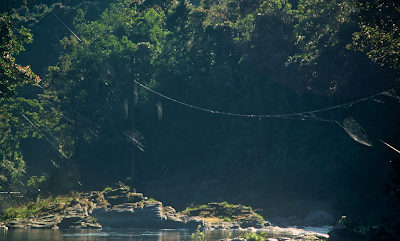
Darwin’s bark spider (Caerostris darwini) is an orb-weaver spider that produces one of the largest known orb webs, with anchor lines spanning up to 25 metres (82 ft). The spider was discovered in Madagascar in the Andasibe-Mantadia National Park in 2009.
The species was named in honour of the naturalist Charles Darwin, with the description being prepared precisely 150 years after the publication of The Origin of Species, on 24 November 2009. Its silk is the toughest biological material ever studied, over ten times stronger than a similarly-sized piece of Kevlar. The average toughness of the fibres is 350 MJ/m3, and some are up to 520 MJ/m3 making the silk twice as strong as any other spider silk known.
Several webs of C. darwini have been seen spanning a river, demonstrating their extreme length. See photo. The web of Darwin’s bark spider is remarkable in that it has not only the longest spanning web ever observed, but is among the largest orb webs ever seen, at an area of up to 2.8 square metres (30 sq ft). Nephila komaci, discovered in 2009, and some other Nephila species also make webs that can exceed 1 m (3 ft 3 in) across.
This position allows the spiders to catch prey flying over the water, with webs observed to large web are thought to have coevolved at the same time, as the spider adapted to the habitat. Scientists are currently researching how the spider is able to weave such a large web over water along with being able to anchor drag lines on either side of a river.Like other spiders of the genus, Darwin’s bark spider displays extreme sexual dimorphism, with large females (18 mm) and small males (6mm).
The spider was described along with an undescribed species of fly, which appeared to have a kleptoparasitic relationship with it. The flies often feed on the spider’s catches before the spider wraps them. Occasionally, spiders have been observed to chase away the flies when they land on something that the spider is eating.Information and pictures were taken from children’s projects and where credited to that child does not claim to be original information. Where possible, permission to reproduce has been sought. Any infringement of copyright is purely unintentional.
darwin’s bark spider habitat
Habitat. Caerostris darwini inhabits montane rainforests and their edges in eastern Madagascar, constructing large webs over water (small streams to medium sized rivers, and even lakes) (Kuntner and Agnarsson 2010).
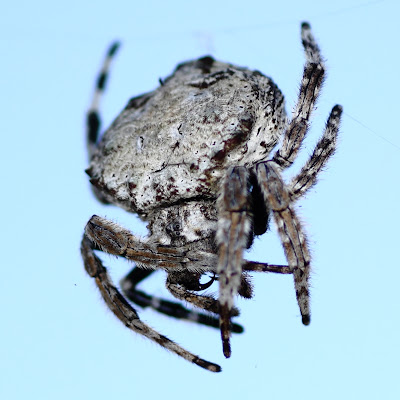
Darwin’s bark spider
This is particularly true of Darwin’s bark spider (Caerostris darwini). The female is Goliath to his David; about 14 times his weight. To seduce her, the male must gingerly traverse her enormous web – a succession of tripwires designed to sense the slightest vibration – and copulate, all without triggering her attacking instinct.
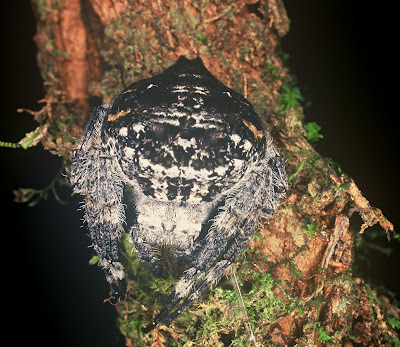
The big spider in the middle of a web is, in fact, always female. Males are little more than walking sacs of sperm without the time, or need, for hunting. Their webs and weaponry are puny in comparison – females have the longest fangs and most potent venom. They also live longer and grow larger in order to nourish as many eggs as possible. To do so they’ve become nature’s greatest (and deadliest) engineers.
What makes Darwin’s bark spider special?
Darwin’s bark spider is the world record holder. Her silk is the toughest biological material ever studied – twice as strong as any other spider’s and 10 times tougher than Kevlar. She uses it to spin the biggest webs ever recorded: one orb measured 2.8m2, with anchor lines over 24m long. She casts over streams with the web resting above water where it can trap flying insects as they hatch. One was found to contain 32 mayflies – their short life rendered even shorter by this extraordinary hunter.
Does the female Darwin’s bark spider really eat her sexual suitors?
She’s not averse to catching and eating her sexual suitors before, during or after sex. Studies have shown that cannibalism provides the female with superior sustenance, as the nutrients derived from the male are effectively tailor-made for making baby spiders. Sexual cannibalism is thus the ultimate act of paternal care, as long as the munched male is actually the father Darwin’s bark spider females are promiscuous, so the male must not only stay alive long enough to inseminate, he must also prevent her from mating with others. To achieve this end, evolution has equipped him with some kinky solutions: bondage and genital mutilation.
First, he times his approach when the female is feeling vulnerable – just after she’s moulted and her exoskeleton is still soft. He then binds her legs with his silk so she can’t grab him. Next he drools on her genital slits. This enigmatic behaviour, not found in other spiders, may be an attempt to seduce her by signalling mate quality, or to digest any previous suitor’s sperm. After insemination, he ensures no other spider’s follow suit by chewing off his own genitals and using them to plug the female. An emasculating finale that secures his legacy, if not his life.
Bark Spiders are a little known group of orb-weavers found across tropical Africa and Asia. Apparently they get their name from the fact that at least some of them look like a bit of bark or dead leaf, which is of course an eminently sensible disguise against predators.。
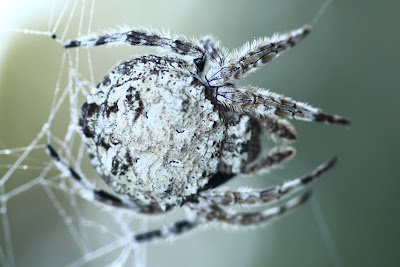
Indeed, it’s so sensible, reasonable, uncharismatic and altogether lacking in eccentricity, that scarcely anyone gave the Bark Spiders a second look. They’re spiders. A bit like how other spiders are spiders. And that’s just not interesting enough in tropical Africa and Asia where there are so many weird, wonderful and gigantic spiders to choose from.
All that changed in 2009 with the belated discovery of Darwin’s Bark Spider in the forests of Madagascar. Although, one can’t help but think that their handiwork must surely have been noted well before that. It’s certainly eye-catching enough.
These mighty bridge lines serve as the frame for the rest of the web, which is suspended beneath. The web proper is traditional with its spokes and spirals, it just happens to be right above a load of water. Also it’s HUGE! The biggest take up an area of 2.8 m² (30 square feet), more than any other web in the world.
All this from a spider that’s less than 2 cm (0.8 in) long! This is a large spider, but large in the sense of a European Garden Spider rather than a Golden Orb-weaver.
With the sheer size of the web and the fact that its failure would mean falling into a river, it’s not surprising to learn that those bridge lines are also incredibly tough. “Tough” here doesn’t mean that it can survive the apocalypse with nothing but a spork and a field guide to edible mushrooms. It’s actually the term used to describe how much force a thing can withstand before getting torn and smashed. The Darwin’s Bark Spider can produce silk twice as tough as any spider silk known thus far, and 10 times tougher than Kevlar.
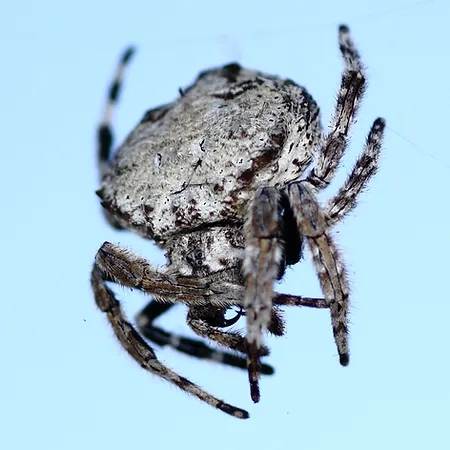
It’s no wonder they look after their webs and make repairs for several days before moving on to make a whole new one elsewhere. If only we could convince them to stay in one place. We could replace all those stupid rope bridges that seem to cause everyone so much trouble. Though I suppose Indiana Jones wouldn’t have been able to cut his one so easily, but that’s just the price we pay for progress.
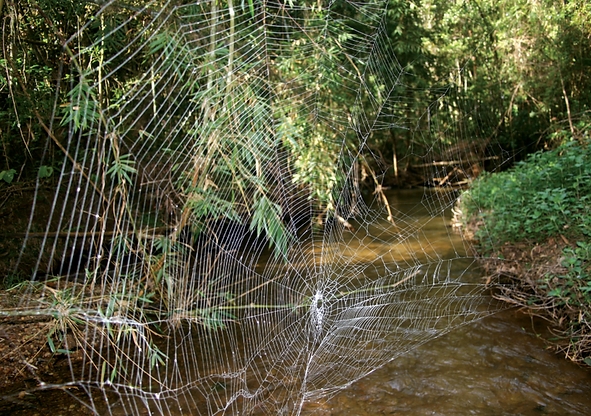
These powerful, gargantuan webs naturally catch a lot of prey. One was spotted with 32 mayflies, and the spider gathered them up and wrapped several corpses together in a macabre, silk-covered orgy. Alas, so much meaty fruit hanging on the vine attracts a LOT of flies. They’re buzzing around, eating prey that hasn’t been wrapped up, eating prey that has been wrapped up… there were ten spotted eating prey the spider was currently eating! No shame and no fear. Some of these good-for-nothing parasites were even new to science! New talent, new hangers-on.
It’s strange, these spiders. What must it be like to create your home and means of survival from your own backside? Some day, when we’ve sorted out the technology to turn our faeces into power, we’ll begin to understand.
